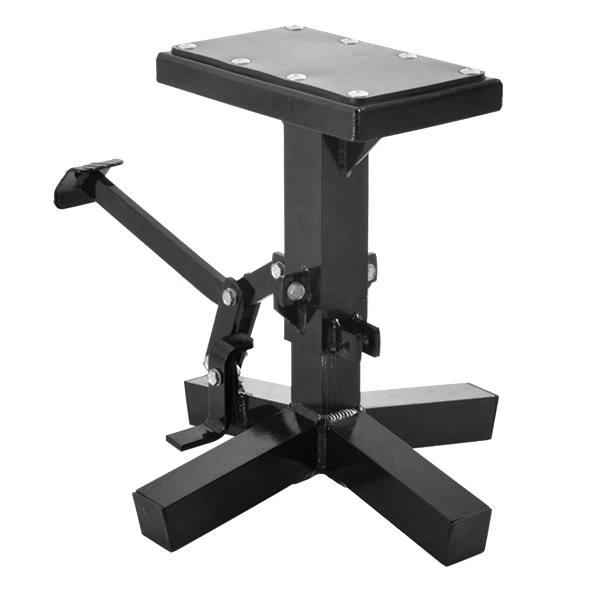How to Prevent Accidents When Using Motorcycle Lifts?
For the sake of both the riders and the motorcycle lifts, it is imperative that incidents involving these devices be avoided at all costs. To ensure a secure lifting process, always inspect your motorcycle lift stand before use, checking for any signs of wear or damage. Position your bike correctly on the lift, ensuring it's balanced and stable. Make sure to use gloves and protective shoes as directed.Never exceed the weight capacity of your lift, and always follow the manufacturer's guidelines. Keep your work area clean and free of obstacles. Lastly, never rush the process - take your time and double-check everything before and after lifting. By adhering to these precautions, you can significantly reduce the risk of accidents and enjoy a safer maintenance experience.

Understanding Motorcycle Lift Safety Fundamentals
Types of Motorcycle Lifts and Their Safety Features
A wide variety of motorcycle lifts are available, each with its own set of security measures. Smooth operation and safety locks are common features of hydraulic lifts. Scissor lifts provide stability through their wide base and multiple locking positions. Air-powered lifts allow for precise control but require proper air pressure maintenance. Understanding these differences helps in choosing the right lift for your needs and using it safely.
Importance of Weight Capacity and Stability
Every motorcycle lift stand has a specified weight capacity. Overgoing this limit can cause a fatal failure. Always check your bike's weight and ensure it's within the lift's capacity. Stability is equally crucial - a wider base generally offers better stability. Some lifts feature adjustable legs or pads to enhance stability on uneven surfaces. Prioritizing these aspects significantly reduces accident risks.
Pre-Use Inspection Checklist
Before each use, conduct a thorough inspection of your motorcycle lift. By double-checking for indicators of metal fatigue, worn components, and loose bolts, you can avoid numerous accidents. Lubricate all moving parts as needed. Verify the correct operation of all safety latches and mechanisms.
Proper Lifting Techniques and Procedures
Correct Positioning of the Motorcycle
Proper positioning is vital for safe lifting. Align your motorcycle carefully on the lift platform, ensuring it's centered and balanced. Use the designated lifting points on your bike - these are usually the frame or swingarm. Avoid lifting by the engine or exhaust components. Some lifts have adjustable arms or pads to accommodate different motorcycle designs - use these features to achieve optimal positioning.
Step-by-Step Lifting Process
Start by engaging any wheel chocks or stabilizers on the motorcycle lift. Slowly raise the motorcycle lift, pausing frequently to check for any signs of instability. As you lift, listen for any unusual sounds that might indicate stress on the motorcycle lift or motorcycle. Once at the desired height, engage all safety locks before beginning work. When lowering, release the locks gradually and maintain control throughout the descent.
Using Safety Straps and Additional Support
Even with a stable lift, using safety straps adds an extra layer of security. Attach straps to solid points on both the motorcycle and the lift. For extended work sessions, consider using additional support stands under the motorcycle frame. This redundancy can prevent accidents if the primary lift system fails.
Maintaining and Upgrading Your Motorcycle Lift
Regular Maintenance Schedule
Establishing a consistent maintenance schedule for your motorcycle lift stand is essential to ensure safe and reliable operation. Begin by cleaning the lift thoroughly to remove dirt, dust, or grease that may interfere with functionality. Follow the manufacturer’s instructions for lubricating hinges, joints, and other moving parts. If using a hydraulic lift, routinely inspect and top off fluid levels; for pneumatic models, verify air pressure regularly. Make it a habit to inspect for loose bolts or fittings and address any irregularities immediately to avoid operational delays or potential accidents caused by overlooked issues.
Recognizing Signs of Wear and When to Replace Parts
Monitoring your lift for visible signs of wear is critical to preventing failures during use. Surface rust, faded paint, and corrosion can weaken structures, therefore it's important to check for them often. Particularly in places that take a beating from constant lifting and loading, inspect welded joints and structural parts thoroughly. Unusual noises or jerky movements during operation can indicate internal damage or misalignment. If any components show cracks, excessive wear, or instability, replace them without delay. Prioritizing timely part replacement is a smart way to maintain safety and extend the life of your lift.
Upgrading Safety Features
With technological advancements in lifting equipment, upgrading the safety features of your motorcycle lift can dramatically improve both functionality and operator protection. Consider retrofitting your lift with dual-lock safety systems, anti-slip platforms, or adjustable wheel chocks to increase security during use. Enhanced stability systems, such as wide-footprint bases or cross-bracing, can offer better balance under heavy loads. Newer models may include wireless or foot-pedal controls, reducing direct contact during operation. Staying informed about these upgrades and implementing them as needed can help you maintain a safer and more efficient working environment over time.
Conclusion
Knowing what you're doing, utilising the correct technique, and keeping up with maintenance are all necessary to avoid mishaps while using motorcycle lifts. You may make your workplace safer by learning the capabilities of your lift, following the proper protocols, and maintaining your equipment well. Remember, safety is not just about protecting your motorcycle - it's about safeguarding yourself and others in your workspace. You may look forward to stress-free maintenance visits for many years if you consistently apply these tactics.
Contact Us
For more information about our high-quality motorcycle lifts and stands, or to discuss your specific needs, please don't hesitate to contact us at info@runva.com.cn. Our team is committed to helping you find the safest and most efficient solutions for your motorcycle maintenance needs.
References
Smith, J. (2022). The Complete Guide to Motorcycle Lift Safety. Rider's Digest Magazine.
Johnson, A. et al. (2021). Accident Prevention in Motorcycle Maintenance. Journal of Automotive Safety, 15(3), 78-92.
Motorcycle Safety Foundation. (2023). Best Practices for Using Motorcycle Lifts. MSF Safety Series.
Brown, R. (2020). Innovations in Motorcycle Lift Technology. Mechanic's Monthly, 45(2), 34-41.
National Institute for Occupational Safety and Health. (2022). Safety Guidelines for Automotive Lifts. NIOSH Publication.
Thompson, L. (2023). Maintaining Your Motorcycle Lift: A Comprehensive Guide. DIY Motorcycle Maintenance, 8(4), 112-125.

_1737625693698.webp)

